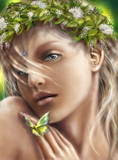Imbolc is a festival of preparing for renewal and growth. It’s symbolic of fertility and ridding of the old, making way for the new. Farm animals have given birth or will have their babies soon. This is the midpoint of the dark part of the year. It is the festival of the Maiden Brighid. Her snake emerges to test the weather, the basis for Groundhog Day. In many places, crocus flowers bloom, a sign of spring to come.
The celebration is also called the Feast of Lights, Feast of Torches, Feast of the Virgin, Feast of the Waxing Light, Festival of the Ewe’s Milk, Festival of Lights, Imbolgc Brigantia, Lupercus, Candlelaria, Snowdrop Festival, Greater Sabbat and Solar Festival.
Imbolc Traditions
Straw Brideo'gas (corn dollies), are created from oat or wheat and rest in baskets with white flower bedding. Girls carry them from house to house where gifts are bestowed upon the dollies.
Afterwards, older women make acorn wands for the Brideo’gas. Brighid's Crosses are created from wheat stalks and exchanged as symbols of protection and prosperity. Hearth fires are put out and re-lit. Besoms (brooms), are placed by front doors to symbolize sweeping out the old and welcoming the new. Lit candles are placed in each room to honor the re-birth of the Sun.
The plough is a traditional symbol of Imbolc. In areas where this is the first day of ploughing, a decorated plough is pulled from home to home. Costumed children follow, asking for refreshments or money. If they are refused, the house’s front garden is ploughed over. In other places, ploughs are decorated and whiskey is poured over them. Cheese and bread are left by the tools as offerings to nature spirits.
Imbolc Activities
It’s a time to hike in nature to find signs of the impending arrival of spring, perhaps a crocus or a robin. Priapic wands, symbols of fertility, are made from sticks, acorns, small bells and gold, yellow, green and brown ribbons or yarn. Bride's beds and Brideo’gas are created and ploughs, decorated. There’s feasting, candle lighting and bonfires aflame.
Of Things Imbolc
Symbols: white flowers, snowflakes, besoms, candle wheels, Brighid crosses, Priapic wands, Brideo’gas and ploughs.
Colors: white, light green, yellow, brown, pink, red.
Crystals: ruby, garnet, amethyst, bloodstone, turquoise and onyx.
Flowers: violets, wisteria, heather, iris and white and yellow flowers.
Herbs and incense: Bay leaves, angelica, cinnamon, basil, celandine, myrrh, coltsfoot, laurel, vanilla, blackberry and tansy.
Food and drink: all dairy products, breads, cakes, scones, muffins, raisins, pumpkin and sunflower seeds, greens, bell peppers, onions, garlic, herbal teas, ale, mead and spiced wines.
Groundhog Day
Brighid’s snake appeared on Imbolc to test the weather. Over the years, the snake became a hedgehog or a badger. It was the immigrants from the Palatinate region of Europe, known as the Pennsylvania Dutch, who brought the custom of Groundhog Day to America. Hedgehogs aren’t native to America and badgers are very aggressive. Groundhogs, also called woodchucks, were plentiful, so they substituted for hedgehogs.
The town of Punxsutawney Pennsylvania has celebrated the day since the 1800s. Phil, its groundhog, is probably the most famous of the predictors. On February 2, he emerges from his burrow. The question in onlookers’ minds is whether or not he’ll see his shadow. If he does, winter will last for another six weeks.
Sources:
Buckland’s Complete Book of Witchcraft, Raymond Buckland, (Llewellyn Publications, 1990)
Cunningham’s Encyclopedia of Crystal, Gem & Metal Magic, Scott Cunningham, (llewellyn Publications, 1989)
Thursday, January 21, 2010
Subscribe to:
Post Comments (Atom)



No comments:
Post a Comment